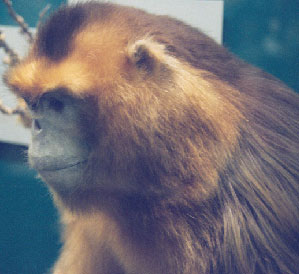This species has a sacculated stomach and symbiotic bacteria in the stomach to assist in the breakdown of cellulose (Gao and Liu, 1995). The teeth, masseter muscle and temporalis muscle of the golden snub-nosed langur are stronger as compared to other Chinese monkeys, which assist in the processing of food that contains a large amount of roughage (Gao and Liu, 1995). This species has high levels of sexual dimorphism as compared to other Old World monkeys (Jablonski and Ruliang, 1995). Males have a pair of fleshy flaps on their upper lip (Qi, 1986). This species has an upturned snub nose, hence the common name (Qi, 1986). The average body mass for an adult male golden snub-nosed langur is around 15.0 kilograms, and for the female it is between 6.5 and 10.0 kilograms (Fleagle, 1988). The golden snub-nosed langur has a dental formula of 2:1:2:3 on both the lower and upper jaws (Ankel-Simons, 2000). This species moults its fur between August and October (Davison, 1982). The male's penis is black and the scrotum is bluish white in coloration (Davison, 1982). The perineum of the male is bright blue in a narrow line, with sky blue skin surrounding the ischial callosities (Davison, 1982). The coloration of the male's perineum mimics the facial coloration, which is convergent with the mandrill, Mandrillus sphinx (Davison, 1982). Adult males also have secondary sexual characteristics including: large canines, upper-lip warts, and long hair on the back (Liang et al., 2000). Large canines start to appear at 4.9-5.4 years, upper-lip warts begin to appear from 5.4-6.2 years, and back hair begins to appear from 5.6-6.3 years of age (Liang et al., 2000).
